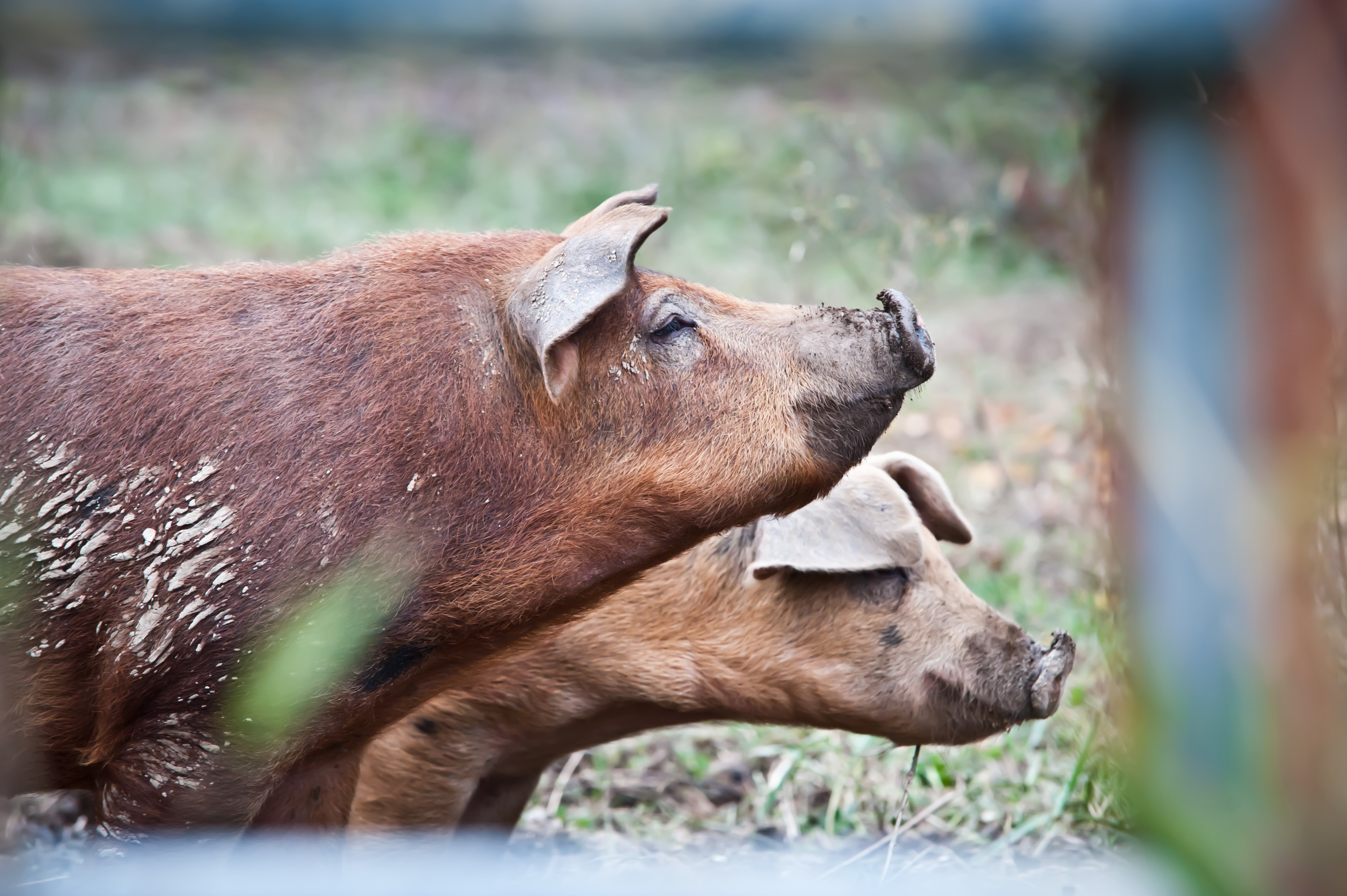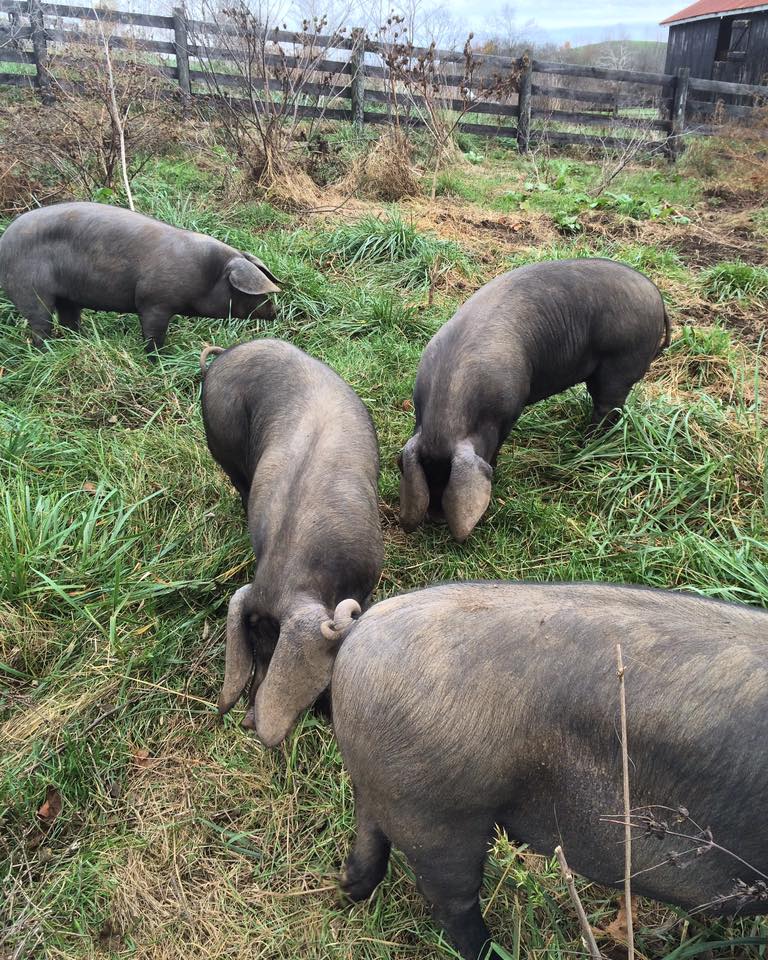By now, most consumers and retailers are aware of the growing demand for products with ‘natural’ label claims such as grass fed beef or free range chicken. A quick visit to your local or regional grocery store will demonstrate that the demand is real. Authentic and green-washed items are being grabbed up by a growing number of consumers who are trying to make healthier and environmentally conscious protein choices.
But what about pork? Although it’s not as though there are no programs advertising ‘natural’ or ‘sustainable’ pork products, it is almost impossible to find a pork program that is produced purely on pasture. So why is pastured pork so late to the party?
Well, here are two important facts to know about pork that help explain the slower adoption of pastured pork by consumers:
1. Litter Size: A sow can produce 1 litter every 4 months (roughly), and each litter may contain 8-12 piglets.
Comparison with Cattle: A beef cow produces 1 calf per year. That is a big difference in quantity of offspring!
2. Maturity Time: A piglet reaches maturity (and slaughter weight) at 6 months old. So, keeping in mind that 1 sow produces 2-3 litters of 8-12 piglets/year, that means that from just 1 sow, as many as 30+ mature hogs hit the market each year. That’s a lot of pork!
Comparison with Cattle: It takes a calf 18-24 months to reach maturity (and slaughter weight). So that’s almost 2 years to reach the market.
Both of these factors directly affect the pork quantity available on the market. Because of the litter size and maturity time, there is a much higher quantity of commodity pork available on the market. And as Economics 101 tells us, when quantity goes up, demand goes down, and so does price.
THE RESULT: Consumers are used to paying very low prices for pork.

But why is it more expensive to take pastured pork to the market? The two facts already mentioned about our prolific pigs, as well as a few others, make pork production particularly suited to confinement farming operations. In confinement operations, all hogs are kept inside all of the time. Even in smaller scale natural programs, if the hogs aren’t indoors they are on concrete or dirt. And even though the gestation period and ability to produce offspring is not much different in hogs that are raised on pasture, the number of animals in a single area is necessarily much lower. In confinement operations, the number of hogs that can be kept in an area is huge – large sows are allowed as small as a 2’x7’ area, and smaller animals even less. Also in confinement settings, the farmer doesn’t want hogs to burn calories exercising, so all their feed is delivered to their pins.
Farmers that implement pasture operations know that providing pasture access changes everything. Grass, insects, roots and nuts are a crucial part of their diet, so pastured pork producers want to preserve their land and not exhaust its capabilities by overstocking or leaving the pigs in a single area for too long. A good rule of thumb for pastured hogs is one acre for 50 hogs for one week – that’s over 800 sq. ft per hog every week as opposed the 14 sq. ft for the animal’s entire life!

The process of pasturing pork is aligned with animal welfare practices, cheaper and easier for farmers to get started, protects the environment, and the end product has health benefits to the consumer. All that said, it definitely makes a smaller number of finished hogs in a year’s time, and the man-hours per animal are greatly increased. This, coupled by the fact that pastured hogs are typically not processed in a large scale facility, explains why there is such a tremendous price difference in the finished product. And perhaps that is the reason major grocery store chains have not embraced it… yet.
Pastured pork has advantages for the pigs, for the farmers, for the land, and for the eater. But it does cost more to produce. Our experience has shown that people are more prepared to base their food purchase decisions around taste and eating experience than other attributes. So, can the superior flavor of pastured pork stand out enough to justify the cost to consumers?
Well, let’s get some expert opinions.
Chef Cody Stone of Decca Restaurant in Louisville, Kentucky once conducted a blind test with Marksbury pastured pork vs a few popular brands of “natural” pork from out west. The result according to Cody: “It wasn’t even close.” This was several years ago, and Marksbury pasture raised pork remains a constant on their menu to this day.
And if you read renowned chef Sean Brock’s views on pork production, you will begin to see that the restaurant world is all in on pastured pork. The benefits of pastured pork are straight forward – better quality of fat, richer in color and flavor, and the ability to source directly from small scale producers has led to a surge in the use of pastured pork among discerning chefs.
So if you are a consumer who wants pastured pork to fully enter the mainstream, start asking your local and regional grocery markets for pasture raised pork. Ultimately the consumer owns the marketplace, so persistent and frequent requests for a product can eventually lead to seeing it on the shelves. And in the meantime, thank goodness for the growing popularity of grass fed beef and pasture raised chicken. The growing interest in sustainably raised beef and poultry has laid the groundwork for their porcine allies to join them on the mainstream supermarket shelves.
Want more information? Sign up for our newsletter at the top of this page, or follow us on social media for updates.

